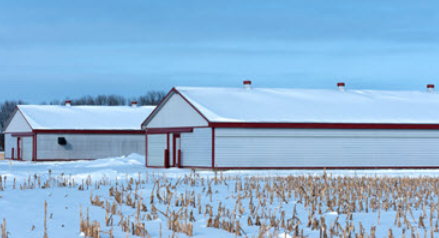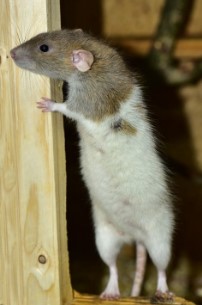
SimplyCreativePhotography\iStock\Getty Images Plus photo
By Elizabeth Ferry, Casey Zangaro
As fall and winter season come to fruition, so does the increased potential of rodents and pests coming into livestock facilities. Although minor infestations of rats and mice may not be worrisome for many, as it is common on farms, it is important to understand that even the slightest infestation can affect your bottom line. Pests can have many impacts on your daily operations. Examples of these are the rodent consumption of feed which does add up to feed losses and potentially contaminated feed, the potential for spreading disease to or within a facility, and issues with building maintenance as rodents tend to undermine building foundations, concrete slabs, electrical wiring, and infiltration openings throughout the facility. These factors, along with others, ultimately affects the economic viability of any swine operation and if a rodent control program is not implemented the facility is at risk for a major infestation.
 Keeping up-to-date on the rodent control process is an on-going awareness and building a rodent control plan takes many steps. Farms should consider developing Standard Operating Procedures for the sites which will help bring consistency as the steps of the plan are completed and will meet the requirements of various assessment programs.
Keeping up-to-date on the rodent control process is an on-going awareness and building a rodent control plan takes many steps. Farms should consider developing Standard Operating Procedures for the sites which will help bring consistency as the steps of the plan are completed and will meet the requirements of various assessment programs.
The first step to a comprehensive rodent control plan is to develop methods for decreasing the rodent population around a facility. There are various building design suggestions and operational recommendations that will help control the rodent population at a facility. Some of these include:
- Maintain a 19-inch barrier of stone or crushed concrete surrounding the site
- Complete routine inspections for signs of rodent infestations
- Keep trash and feed cleaned up around the facility
- Complete regular outdoor maintenance before and after extreme weather
- Maintain baffles around cables and pipes
- Utilize kick plates on the lower edge of the doors
- Place flaps or crushed wire mesh on inlets
Another one of the major components of a rodent control plan is to develop methods of observation for increased signs of rodent populations. Along with routine baiting, employees and farm staff should be making observations about rodent activity and be ready to respond to increases in activity. It is important to understand that rodents are not active around daytime, but will be noticed more around dusk and nighttime. Although many times you will not see rodent movement throughout the day, employees should be trained to look for sign of rodents on the farm. These signs include:
- Vocalization or Squeaking
- Gnawing on wires and fabrics
- Droppings around walls, behind walls, and near food supply
- Burrow patterns around the outside of the facility
- Smudge marks in the dust on pipes and rafters
Special care should be taken when making observations in common places where evidence of rodents is typically seen:
- Doorways
- Feed bins or loose feed
- Near walls and or cracks around the facility
- Windows or ledges
- Areas of vegetation adjacent to or around facility
Another step to developing a rodent control program is to design a process for routine pest control and baiting at your facility. A common control practice is to have rodent boxes with rodent bait inside. Boxes should be placed around major rodent pathways and near doorways. Rotating rodent baits is also a good practice, as well as continually checking and replacing bait when necessary. The table below shows the various rodenticides that can be used.
Table 2. U.S. Rodenticides Commercially Available (Adapted from Timm, 2010)
|
| Compound | Classification | Trade Names | Applied Form |
| Warfarin | 1st generation anticoagulant | Various | Meal, Water |
| Pindone | 1st generation anticoagulant | Pival TM, Pivalyn TM | Meal, Water |
| Diphacinone | 1st generation anticoagulant | Ramik TM, Rampage TM, Tomcat TM | Blocks, Blocks, Liquids |
| Chlorophacinone | 2nd generation anticoagulant | Rozol TM | Pellets |
| Brodifocum | 2nd generation anticoagulant | Havoc TM, Jaguar TM | Blocks and Pellets, Blocks |
| Bromadialone | 2nd generation anticoagulant | Boothill TM, Hawk TM | Blocks, Meal and Blocks |
| Difethialone | 2nd generation anticoagulant | Hombre TM, Fast Draw TM | Blocks, Soft bait |
| Difenacoum | Non-anticoagulant CNS toxin | DiKill TM | Blocks and Pellets |
| Bromethalin | 1st generation anticoagulant | Cy-Kil Tm, Rampage TM, Gunslinger TM | Blocks and Pellets, Blocks, Blocks and Pellets |
| Cholecalciferol | Non-anticoagulant vitamin D3 | Agrid TM | Blocks and Pellets |
| Zinc Phosphide | Non-anticoagulant phosphine toxicity | Eraze TM | Pellets |
The active ingredients in rodenticides vary from product-to-product and can be classified in 3 different ways; acute, sub-acute and chronic.
Acute rodenticides are fast acting and normally are effective within 24 hours.
Sub-acute rodenticides cause death after several days. The lethal dose of the rodenticide may be consumed early on and feeding of this bait may continue until death.
Chronic rodenticides are slow acting and cause death as early as 2-3 days or on average from 5-7 days.
Understanding what ways you will be using rodenticides, preventing, control or eradication, will help you decide what product best fits your need.
When considering your bait products, you should also think about the different forms that bait is available in, these include; meals, cut or whole grain, pellets, wax blocks, edible lards/pastes/gels, contact gels or foams and gases. Particulate-based baits have been noted to be more palatable to rodents, compared to wax blocks. Whereas wax blocks are better in adverse conditions and areas like sewers and drainage pipes. What types of rodents and the damage you are dealing with may dictate what bait formation you choose?
In summary, rodents can be a major economic threat to swine facilities if not routinely monitored. It is important to be constant in your rodent control measures, such as knowing and observing for signs of increased populations, checking and changing out rodent baits, removing of dead pests around facility, and regularly documenting all these practices. This, in return, should reduce the health and hazard risks for both the animals and employees on site.
Source : msu.edu